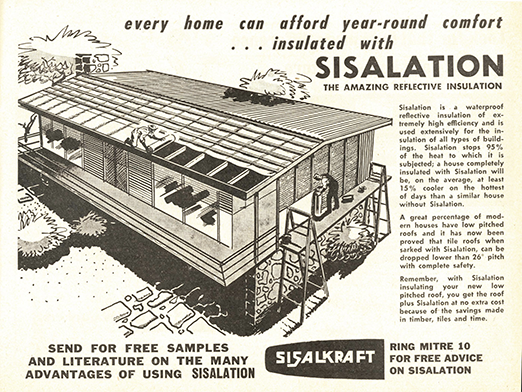We, at Fletcher Insulation, share a heritage steeped in insulation manufacturing dating back to the 1930s. Our story begins with the Sisalkraft company, that specialised in crafting packaging materials, wall wraps and sarkings, establishing itself in Australia in the thirties. From its first factory in Australia, the Sisalkraft reinforced bitumen laminated papers quickly became a sought-after material, valued by both the packaging and building industries.
A transformative turn took place in the 1940s when Sisalkraft introduced aluminium foil onto its already market leading paper-based product, giving birth to the game-changing Sisalation®. This reflective foil laminate not only protected the build from the elements, it contributed to thermal resistance, setting a new benchmark in the construction industry,
Simultaneously, a groundbreaking development was underway in the United States that would help make Fletcher Insulation what it is today. Up until then, rockwool was the prevalent form of building insulation – a fibrous bulk insulation derived from molten rock. However, a serendipitous discovery a Corning Glass in 1932 led to the creation of glasswool. This marked the birth of Owens Corning a few years later, formed through a merger with Owens-Illinois, another glass manufacturer.
By the 1950s, glasswool insulation had made its mark in residential construction. To stand out in a competitive market, a distinctive pink dye was added to the Owens Corning insulation, forever distinguishing it from rivals’ products. The introduction of the bright pink colour in 1956 became a powerful tool to help identify this world leading insulation, eventually trademarked in 1985 as PINK®, an enduring symbol of Owens Corning.
In the 1960s, ACI (Australian Consolidated Industries), a major glass manufacturer with a conglomeration of businesses, set up Australia’s first purpose-built glasswool batt and blanket manufacturing facility in Dandenong, Victoria. ACI licenced its glasswool manufacturing technology from Owens Corning giving rise to Pink Batts® in the Australian market.
In 1979, the emergence of the Insulco insulation business in Australia further enriched the market, gaining market share throughout the 1980s and 1990s with its own brands – Fat Batts and Vapa-Check.
Starting in 2003, our parent company, Fletcher Building, embarked on a strategic journey in the Australian market, culminating in a series of acquisitions. The original ACI and Insulco insulation businesses, with different owners and names over the years, were brought into the Fletcher Building group in 2005, including the Sisalation products, the ACI Insulation glasswool manufacturing facility in Dandenong and the Owens Corning PINK license. The Owens Corning licence under ACI gave the business access to world class insulation manufacturing technology The new Australian company was called Fletcher Insulation – a pivotal milestone that firmly established us as a key player in the industry. Today, we, at Fletcher Insulation, take immense pride in carrying forward this legacy, manufacturing and distributing market-leading insulation products.
Image1: Mitre 10 Trade Catalogue ad for Sisalation, June 1960, courtesy Museum of History NSW
Image 2: ACI distributor Just-rite, Pink® Batts newspaper ad, Canberra Times (ACT:1926-1995), September 4 1982: 9, National Library of Australia http://nla.gov.au/nla.news-article116468126






